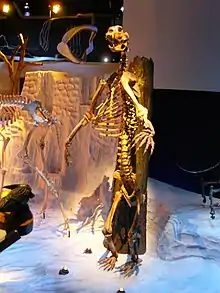Tremarctos floridanus
Tremarctos floridanus, occasionally called the Florida spectacled bear, Florida cave bear, or rarely Florida short-faced bear, is an extinct species of bear in the family Ursidae, subfamily Tremarctinae. T. floridanus was widespread in the Southeastern United States during the Rancholabrean epoch (250,000–11,000 years ago), with scattered reports of fossils from other parts of North America and from earlier epochs.
| Tremarctos floridanus Temporal range: | |
|---|---|
 | |
| T. floridanus skeleton | |
| Scientific classification | |
| Domain: | Eukaryota |
| Kingdom: | Animalia |
| Phylum: | Chordata |
| Class: | Mammalia |
| Order: | Carnivora |
| Family: | Ursidae |
| Genus: | Tremarctos |
| Species: | †T. floridanus |
| Binomial name | |
| †Tremarctos floridanus (Gidley, 1928) | |
| Synonyms | |
|
Arctodus floridanus Gidley, 1928 | |
Environment
T. floridanus was widely distributed south of the continental ice sheet, along the Gulf Coast through Florida, north to Tennessee and South Carolina during the Rancholabrean epoch (250,000–11,000 years ago). A few fossil specimens have been reported from the Irvingtonian (2.5 million–250,000 years ago) and Blancan (4.75–1.8 million years ago) epochs in western North America.[1] Fossils of T. floridanus have been reported from two sites in Belize.[2][3]
Arctodus (3 million–11,000 years ago) was a contemporary and shared its habitat with T. floridanus. The closest living relative of the Florida cave bear is the spectacled bear of South America; they are classified together with the huge short-faced bears in the subfamily Tremarctinae. They became extinct at the end of the last ice age, 10,000 years ago (possibly as late as 8,000 years ago at Devil's Den in Florida).[4]
Taxonomy
Originally, Gidley named this animal Arctodus floridanus in 1928. It was recombined as T. floridanus by Kurten (1963), Lundelius (1972) and Kurten and Anderson (1980).[5][6] The type specimen was found in the Golf Course site of the Melbourne Bone Bed in Melbourne, Florida.[1]
Fossil distribution
Sites:
- Anza-Borrego, California (Irvingtonian epoch)[7]
- Aucilla River in Jefferson County, Florida[1]
- Cebada Cave, Belize[2]
- Cutler Fossil Site, Miami-Dade County, Florida[8]
- Devil's Den Cave, Marion County, Florida[9]
- Edisto Beach, South Carolina (Rancholabrean epoch)[10]
- El Golfo, Sonora (Irvingtonian epoch)[7]
- Extinction Cave, Belize[3]
- Haile Quarry site, Alachua County, Florida[1]
- Harleyville, South Carolina (Rancholabrean epoch)[10]
- Ingleside, Texas[11]
- Myrtle Beach, South Carolina (Rancholabrean epoch)[10]
- Rock Spring, Orange County, Florida[1]
- Runnymede Plantation, South Carolina ("Tremarctos sp.")[12]
- San Simon, Arizona ("Tremarctos sp.", late Blancan epoch)[7]
- Other sites in Florida, including in Alachua, Brevard, Citrus, Columbia, DeSoto, Duval, Indian River, Lake, Levy, Marion, Miami-Dade, Nassau, Pinellas, St. Johns, Taylor and Volusia counties.[1]
References
- Harrington, Arianna (April 10, 2015). "Tremarctos floridanus". Florida Museum (University of Florida). Archived from the original on October 30, 2021. Retrieved February 26, 2022.
- Czaplewski, Nicolas J.; Krejca, Jean; Miller, Thomas E. (2003). "Late Quaternary Bats from Cebada Cave, Chiquibul Cave System,Belize" (PDF). Caribbean Journal of Science. 39: 23 – via Belize Foundation for Research and Environmental Education.
- Churcher, C. S. (March 2020). "Pleistocene mammals from Extinction Cave, Belize". Canadian Journal of Earth Sciences. 57 (3): 366–376. Bibcode:2020CaJES..57..366C. doi:10.1139/cjes-2018-0178. S2CID 182629185.
- Kurtén and Anderson: 56, 178-79
- E. L. Lundelius. 1972. Bureau of Economic Geology Report of Investigations 77.
- Kurtén and Anderson: 178-80
- "Tremarctos floridanus-Florida spectacled bear". UTEP Biodiversity Collections. 3 April 2013. Retrieved February 27, 2022.
- Carr, Robert S. (2012). Digging Miami. Gainesville, Florida: University Press of Florida. p. 32. ISBN 978-0-8130-4206-0.
- Purdy, Barbara A. (2008). Florida's People During the Last Ice Age. Gainesville, Florida: University Press of Florida. ISBN 978-0-8130-3204-7.
- Sanders, Albert E. (2002). "Additions to the Pleistocene Mammal Faunas of South Carolina, North Carolina, and Georgia". Transactions of the American Philosophical Society. 92, Part 5: 33–40. ISBN 9780871699251 – via Google Books.
- Kurtén, Björn (June 1, 1963). "Fossil Bears from Texas" (PDF). The Pearce-Sellard Series (1): 13 – via University of Texas Libraries.
- "Tremarctos sp., Bear tooth". The Charleston Museum. Retrieved February 27, 2022.
- Kurtén, Björn; Elaine Anderson (1980). Pleistocene Mammals of North America. New York: Columbia University Press. ISBN 0-231-03733-3. Retrieved 26 January 2013.